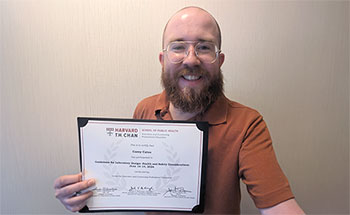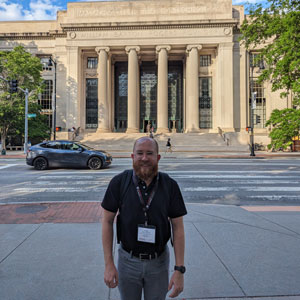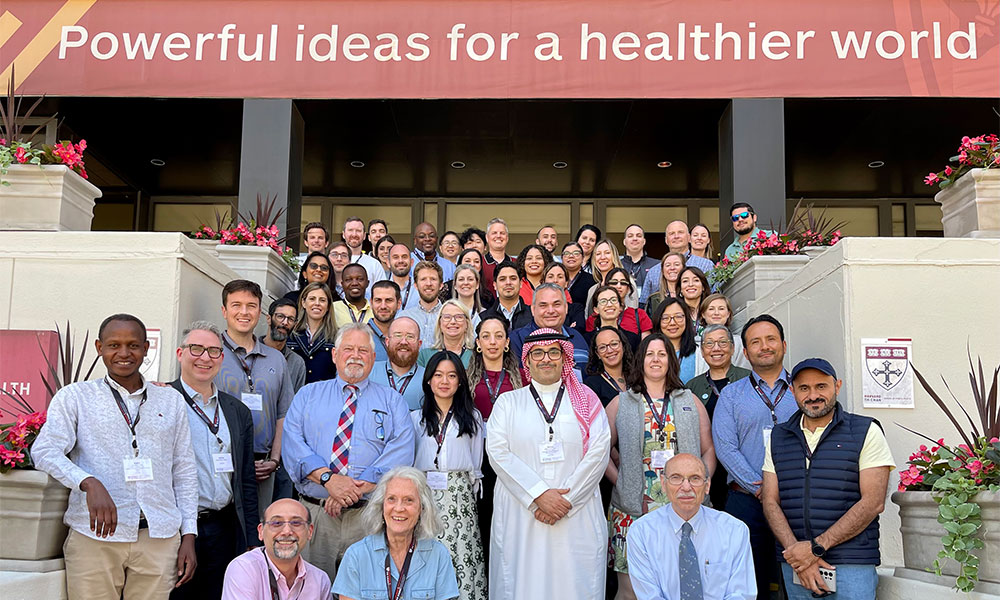written by Sarah L. Minor, MS
 Corey Cates, facilities coordinator II in the Department of Medicine chair’s office, recently learned more about lab design safety by attending the “Guidelines for Laboratory Design: Health and Safety Considerations” course, a weeklong program hosted by the Harvard School of Public Health. The course featured expert-led sessions and tours of cutting-edge laboratories at both Harvard and MIT. The course provided Cates with a comprehensive understanding of the logistical challenges involved in lab renovations, decommissioning, and relocations—key areas in his facilities management career. With this new knowledge, he feels more confident collaborating with the various stakeholders in these processes.
Corey Cates, facilities coordinator II in the Department of Medicine chair’s office, recently learned more about lab design safety by attending the “Guidelines for Laboratory Design: Health and Safety Considerations” course, a weeklong program hosted by the Harvard School of Public Health. The course featured expert-led sessions and tours of cutting-edge laboratories at both Harvard and MIT. The course provided Cates with a comprehensive understanding of the logistical challenges involved in lab renovations, decommissioning, and relocations—key areas in his facilities management career. With this new knowledge, he feels more confident collaborating with the various stakeholders in these processes.
The course is directed by co-authors of all four editions of the foundational textbook, Louis DiBerardinis, MS, CIH, CSP, and Janet Baum, AIA. First introduced by DiBerardinis and Baum in 1987, these guidelines have been the primary source of information on laboratory design for more than 37 years.
 Corey Cates in front of MIT.The curriculum covered a broad spectrum of topics, including the latest industry standards for lab design, exposure control devices, and the critical role of HVAC systems in maintaining safety. The theoretical knowledge gained in the classroom was further enriched by hands-on experiences during tours of state-of-the-art labs. Cates was particularly impressed by MIT’s Nanotechnology Lab, one of the world’s most advanced facilities. The behind-the-scenes look at the clean rooms and low-vibration technology was a fascinating complement to the course content.
Corey Cates in front of MIT.The curriculum covered a broad spectrum of topics, including the latest industry standards for lab design, exposure control devices, and the critical role of HVAC systems in maintaining safety. The theoretical knowledge gained in the classroom was further enriched by hands-on experiences during tours of state-of-the-art labs. Cates was particularly impressed by MIT’s Nanotechnology Lab, one of the world’s most advanced facilities. The behind-the-scenes look at the clean rooms and low-vibration technology was a fascinating complement to the course content.
Seeing the practical applications of lab safety measures in real-world settings provided Cates with context for the information presented during lectures. He observed how airflow models and advanced safety features contribute to effective lab design, reinforcing the importance of a well-thought-out environment for research and experimentation.
As Cates reflects on his experience, he is not only excited about the immediate benefits to his role but also about the long-term implications for lab safety and innovation in the department and UAB. With a strengthened foundation in lab design principles, he is ready to contribute to a safer, more efficient research environment that respects both cutting-edge technology and historical context.
“I’m grateful to the DOM for allowing me to attend this course, as the insights gained will significantly benefit my career in facilities, especially after connecting with experts who literally wrote the book on lab design and safety,” Cates said.
Want to learn more about how Corey and the rest of the DOM Facilities Team can help you? Check out the DOM Facilities web page.
 Corey Cates with the Lab Design class at Harvard.
Corey Cates with the Lab Design class at Harvard.